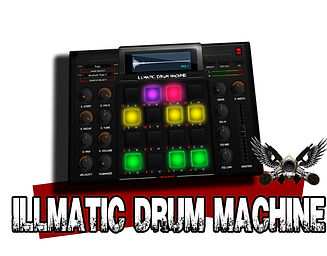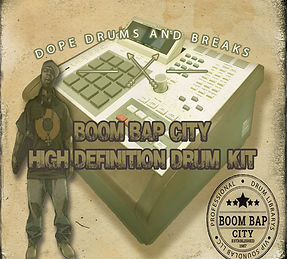

Hooking up External Midi Devices to Maschine
Have you ever asked yourself How can I use the MASCHINE MK 1 and MK 2 hardware to control external MIDI devices in stand-alone mode? Well you can by following ... Read More

FL Studio Mac OS X Beta
We are pleased to announce the FL Studio Mac Public Beta is now available. This is a custom Crossover wrapped version of FL Studio for Mac OS X and so is bit-identical to the Windows installer. NOTE: This is an experimental project and the response from testers will decide if and how we proceed with it. ... Read More

Hip-Hop Tips
Tips and Videos from Hip-Hop Producers ... Read More

10 Common Mixing Mistakes
Dave Penasado is one of my favorite mixing engineer that i like to learn from personally. He has a series on you tube where he goes over the top 10 mixing mistakes that engineers make and how to solve them. Read More

20 Tips On Mixing + Tricks and Tips.
The vocals sound great, the drums are really kicking and the guitars are exceptional, but put it all together and what have you got? A mess! Sound familiar? Until you've gained plenty of experience in mixing music, the process can seem very frustrating. There are probably as many correct ways to tackle a mix as there are successful engineers and producers. Even so, I've taken 20 tips that I've found to be helpful over the years and presented them below in the form of a checklist. These are not immutable rules, just general guidelines that can be broken any time you feel you can get away with it. Read More


5 Best Pair of Headphones for Producers
Contrary to what you see in ads, there’s more to headphones than which rapper or DJ has signed off on endorsing them. Particularly for the rigorous demands of DJs, headphones have to deliver amazingly clear sound quality, high sound pressure levels, extreme durability, road-worthiness, ideally provide a little bit of unique panache. We pitted five models against each other from the likes of Beats By Dre, Pioneer, Sennheiser, V-Moda, and Wicked Audio to see which cans deserve your cash .. Read More
MIXING 101 inside look with Dave Penasado
"With 'Beep' I was handed the backing tracks on the first day of mixing, and I worked one and a half days on making the rhythmic foundation of the song simultaneously rhythmic and relentless, as in the old funk saying 'Like a horse you can't get off of.' Building on that foundation, I had kept a really nice spot for the other instruments, which I received the next day. Apart from the bass, they are supporting characters in the middle range, things that indicate the chord changes, and also that allowed me to keep the interest. On the third day I was given the vocals, and because I now had a track that sounded huge, my challenge was to make the vocals sound bigger than life." Read More

Digital Performer 8 Tips
Digital Performer 8 is designed with inspirational features devised to ignite your creative muse, combined with state-of-the-art studio production technologies engineered for the most demanding, world-class recording and production environments. Make no mistake: beneath Digital Performer’s inspired user interface lies a refined audio recording and mixing engine with uncompromising devotion to the absolute highest standards in audio quality, down to the very last sample. Perhaps you would like to integrate this DAW with Maschine's work flow of the amazing controller Editor Template ? Well here how ... Read More

Maxx Volume Tips and Tricks
When it comes to snare drums, MaxxVolume is it! Key reasons to add compression to a snare are to control overall level, smooth out inconsistent strikes, and bring up soft notes like rim shots. This plugin does all these tasks exceptionally well, even adding a gate. Dial down the threshold to keep your snare gently compressed the whole time, then raise the threshold on the soft notes to make them louder and to shrink the dynamic range. Add the gate last, and bingo – you’ve got a killer consistent snare you can build your entire mix around..... Read More
Black Milk - "Rhythm Roulette"
Young Rj breaks down the process behind making De La Souls (Rise And Shine)
MASCHINE 2.0 Installation and Setup Guide

Latest NI Help Center Videos

Secrets to EQ'n Bass for Hip Hop
As a Hip Hop Producer, one thing you must learn to respect is the power of bass and how it can control your entire mix for better or worse. So, for the benefit of your mixes, take note of these important tricks of the trade we reveal below:1) Bass frequencies are omnidirectional. This means the lows within bass instruments contain a lot of power and energy, so powerful they can control the overall output of the master mix level. Plus, your bass track should almost always be panned in the center. Panning your bass other than to the center is senseless, as it will only generate a mix that is lopsided and artificially hot on one side.2) Don't EQ your bass with the same frequencies as you used on your kicks. For example, if you boosted 40-80hz in your kick tracks, then boost around 120hz for your bass, or vice versa. It's very important to avoid accumulation of the same frequencies when dealing with lows as these tracks control the overall output level of your mix. By assigning different frequency settings to each low end track, your overall mix level can become louder. 3) Boosting a particular frequency on a kick track, calls for cutting the same frequency by the same amount on your bass track. Specifically, when boosting 80Hz on a kick track, be certain to cut 80Hz by the same amount on your bass track. Likewise, if you boosted 130Hz on your bass track, cut by the same amount and frequency on your kick track. This secret technique will give your song a far more sculpted low end sound, allowing for a hotter overall mix.
Top Compression Methods Revealed
Ready to achieve optimum, punchy, in-your-face, hip hop compression settings for a kick? a snare? bass? percussion? Learn what compressor settings platinum hip hop producers use below...1) Ratio & Threshold settings dictate amount: Heavy weight producers use Ratio settings 4:1 to 7:1 for most hip hop applications. Ratios 8:1 & above are more effective for limiting, not compression. For Threshold settings, the Pros use anywhere from 10db to 15db of gain reduction on kicks, snares, percussion, bass, or guitar. After you set the ratio and threshold, the real power comes in with your attack and release settings...2) Attack times dictate snap: To ensure the most punch per track in your mix, you need to assign each track it's own compressor attack settings one at a time. Starting with the kick, set your attack to its slowest possible setting. Next, increase the time of the attack until the kicks timbre dulls slightly. Once you've reached this point, decrease the attack time slightly to un-dull the kick timbre and leave it at that setting. Repeat this method for all other tracks you wish to add optimum punch to!3) Release times dictate recovery: Now that you've optimized the attack for each individual track needing punch, now you must assign each track its own release setting, too. Again, starting with the kick, set your release to its fastest possible setting. Next, decrease the time of the release until you hear the compression fully recovers the kick's volume before the next kick pulse begins. Repeat this method for all other tracks needing optimum volume recovery!
Optimize Beats by Eliminating 'Beats'
Note: The techniques below should only be applied when monitoring with a quality subwoofer, preferably no smaller than 10". While you may attempt to apply the same techniques using 8" nearfield monitors, we cannot guarantee the same results nor can nearfield monitors compare to the accurate low frequency monitoring a subwoofer provides.When monitoring mixes through a full professional setup including quality 8"-10" nearfield monitors coupled with a 10"-12" subwoofer, we may be surprised just how much low frequency clutter really exists that simply cannot be heard on smaller setups. But once you are able to hear the overbearing and conflicting low end war going on in your mix, you can finally start correcting those errors resulting in a much cleaner and level-optimized mix!First and foremost, is learning what a "beat" is. And NO...we are not talking about a "beat" as in a "drum beat", we're talking of something entirely different...When the frequency of 2 similar instruments within a song are very close in pitch, but not in exact tune with one another, an undesired artifact is born, causing an adverse, secondary low frequency wave to modulate called a "beat". In acoustics, a "beat" is an interference between two sounds of slightly different frequencies. Avoiding "beats" is particularly important when mixing kicks, sub-bass, and bass guitar instruments within a full production. This is because lower frequency tracks make pitch conflicts stick out like sore thumbs if not tuned with each other. Higher frequency tracks are usually less-problematic when it comes to pitch conflicts.To eliminate "beats", the most favorable approach is to tune all low-end, non-melodic tracks (drums and percussion) to the first musical note in the key of your song, known as the root "tonic". Correcting all these subtle pitch conflicts will deliver the most harmonious interaction between all the low-end non-melodic & melodic instruments in your mix!
Prized Background Vocal Techniques
You've put in some hard work to achieve the perfect lead vocal mix. Now, it's time to bring the song to a new level by adding the background vocals to the mix! Below are some great unknown tips on how to attain some prized background vocal textures...1) Add Silk: Unlike the up front, full-bodied texture of your lead vocal track, take a different complimentary approach with your backing vocals. Add some silk by applying an overall high-pass filter as high as 900hz to the background vocals. The higher the high-pass, the more sheen and silky the texture becomes. Also, for even more sheen, boost 11-12khz 1-4 decibels using high-shelf EQ.2) Add Depth: To ensure a large impressive sound, you need to record several tracks of background vocals: double takes, triple takes, as well as stacking harmonies. Take advantage of this multi-tracking by assigning each track its own panning placement. For example, pan low vocal/harmony tracks hard left & right. Next, pan medium vocal/harmony tracks 75% left & 75% right. Lastly, pan high vocal/harmony tracks 40% left & 40% right. Now your backing vocals will hug around your lead vocal perfectly!3) Add Distance: To further add contrast apart from your lead vocal, apply different effects settings to your background vocal tracks. Typically, heavier effects should be applied to background vocals when compared to lead tracks. This helps add distance & a unique character apart from your lead mix. Some good background effects to apply are subtle ping Mix
Methods used by Top Producers
Building a great mix starts with organizing how you approach it. To ensure you achieve the best mix possible, break down your mix using the same methods the top music producers use. Below, these steps offer the following mix methods to help you avoid rushing or losing focus on achieving the best sound:1) Place priority on mixing the drums & bass first. Achieving a solid drum & bass foundation gives your mix a strong backbone. Take it from us, if you focus on the drums and bass first, the rest of your mix will naturally fall into place.2) Even though many producers mix the entire instrumental song before adding in the lead and background vocals - it's a big mistake! After you've built the drum and bass mix, we recommend moving straight into placing your lead vocal tracks into the heart of it. Build a solid mix with these 3 components first, before adding in your other tracks. 3) After the drums, bass, and vocals are solid, add in your other melodic tracks such as guitar, piano, strings, etc. Leave out any percussion or sound effects at this point. Pan these melodic tracks around the lead vocal, finding a pocket for each addition. Make sure not to compete for the lead vocals attention, but instead support the vocals as complimentary.4) Save the percussion and sound effects tracks for last. Typically, it's wise to pan these last tracks outside your drums, bass, vocal, and melodic tracks. Use your percussion and effects tracks to fill spaces in the mix that seem unbalanced. By this last step, your mix should be well shaped and balanced following these steps!
Tune to the Tonic & Maximize Mixes
When producing Hip Hop, the single most important aspect of the drum mix is the kick. When mixed correctly, the kick serves as a solid foundation behind the whole production. However, what most engineers & producers do NOT know is that there is more to mixing kicks than mere choice of samples, compression settings, & EQ.Hardly discussed at all, is the secret technique used by Pros where the kicks in a mix are finely tuned to the first musical note (tonic) of a song's key. "What's the big deal about tuning a kick to the key of my song?" you might ask. Well, it's a very big deal! In fact, applying this technique correctly can set a producer apart from the sea of amateurs for evermore...The fact is kicks DO have pitch, low frequency pitch. Therefore, in terms of a kick's pitch embedded within a song's own key signature, a kick can either work against or with the resonance of your entire mix. And perhaps even more important, without tuning a kick to the song's tonic, the entire output level of your mix will forever remain un-optimized!What do we mean? We mean "out of tune" kicks equal a forced lower output due to low end pitch & frequency conflicts. In other words, you'll never be able to truly maximize the output of any mix until your kick resonates with the key of the song at hand. Once the kicks in a mix resonate where their pitched oscillations match the song's natural key & primary frequency, the song's dynamic range & output level potential expand greatly!Having just introduced this powerful yet highly guarded technique, there are several crucial aspects you must learn one-by-one.Before diving into further details on "Tune to the Tonic", let's quickly mention how building & constructing kicks may actually involve layering 2 or more kick samples together. For example, you may find that using one kick sample only can't meet all your needs.
You may need to layer 2 or more kicks to achieve an overall desired "kick sound". One kick may be chosen for its low end while another kick is layered over the first kick for its upper range attack or high end ambience. Layering kicks like this is fine. However, the more kicks you use, the more attention you must give to tuning each kick's pitch to the first musical note (tonic) of the song's key.First, starting with a main kick, choose one that has an identifiable low end pitch. Kicks primarily consist of low frequency sound waves in which there is a main, underlying root pitch which can be heard as the loudest (and usually the lowest) frequency above all other combined tones. This loudest frequency is called the "tonal resonance". Once you find and identify the kick's tonal resonance, you'll need to make the kick "resonate".You can make a kick resonate by fine tuning the kick until its loudest and lowest tonal pitch matches and blends with the tonic (first musical note) of your song's key signature. When adjusting the kick's pitch, it's highly suggested that a "cent" adjustment be used. If the software/hardware sampler does not allow such fine tuning, it's possible that you may only get very close and not an exact match with the tonic. This can cause an adverse, and unwanted, secondary wave to modulate called a "beat".By exactly tuning your kick to the tonic of your song's key, you can be confident that the kick will "sing" and resonate in harmony with your entire song. This greatly emphasizes the chord structure of the song and prevents build up of low frequency conflicts that other instruments such as bass guitar and synth bass can introduce.Sometimes it may be difficult to identify which note/key the kick is resonating on and thus, hard to tune to your song's key.
How the Heavy-Weights make Hits
you produced a mad beat. The artist and record company love it. They buy it. They take it into the studio to record vocals to it. Now they're ready to mix. But...is the beat truly as hot as it could be?!? Heavy weight producers would say no! Here's why...Too often in Hip Hop, producers make killer beats only to have artists record vocals over them that simply don't agree with the arrangement of the original beat. The problem is the lyrical ideas of the artist and the production ideas of the producer don't match on first try. when a producer sells a beat that isn't then re-arranged to better fit the lyrical performance that is recorded over it, the overall song will lose it's power due to the vocals & beat clashing.The lesson to be learned is 90% of the time production should not end when the beat is sold.
Heavy weight producers take pride & joy in re-arranging their productions to fit around vocal performances by opening up spaces for certain lyrical lines while adding in new fills & riffs in between other vocal lines. In short, professional producers sculpt their beats around vocal performances.In fact, with the perfect combination of catchy hook vocals answered by catchy hook fills & riffs, hits can truly be born! Nothing makes a better formula for a hit than catchy "question and answer" phrasing. The problem with a lot of amateur hip hop productions is that the artist's vocals (the questions) simply run over the producer's riffs (the answers). Real producers re-pave the road and come out with hits!
5 Essential Mixes Top Producers Use
If you're serious about your career as a Top Music Producer or Engineer, then be sure to collect all of the 5 essential mixes listed below for each song you lay to the mixed master:1) Main Master Mix - This is the main mix to be used for album, single, and radio releases. It's the mix that appeals to the widest audience of listeners.2) Raised Vocals Mix - Just like your main master mix, only with both lead and background vocals raised in level by approximately 1 to 2 decibels. Depending on the demand for your music, industry types may request this special mix.3) Lowered Vocals Mix - Just like your main master mix, only with both lead and background vocals lowered in level by approximately 1 to 2 decibels. Vocal performances can make or break a hit. so we recommend having this mix on hand in case you later vote against the main master mix.4) Television Live Performance Mix - Just like your main master mix, only with no lead vocal. This mix will be used for television and other types of live performances.5) Instrumental Mix - Just like your main master mix, only with no lead or background vocals. This mix serves as material for radio and television promotions, and also gives you the freedom to record different vocal/lyrical performances over the main instrumental mix at a later date. Also, this mix enables you to later edit & rearrange your song without having to redo the instrumental part of the main master mix. make certain you record this important mix!
Golden Secrets to a Great Mix
If you want to impress your listening audience, you've got to cover your basics when mixing your productions. Below are 6 secret methods in order to achieve a professional mix:1) Volume Balancing - All your instrument tracks added together must represent an even/balanced structure with volume. It's easy to lend too much volume to the wrong tracks in your production. Coming up with the proper balance where each track has its own proper level is a practicing art.2) Panorama & Placement - Whether you're mixing in stereo or surround sound, achieving a unique pan & placement for each musical track within a mix is essential. Take it from us proper sound field placement fro all tracks will reveal the detail & beauty of your entire production while, at the same time, satisfying the listener's ears with acoustic balance. 3) Frequency Spectrum - One of the biggest problems producers create for themselves is not making sure to fulfill the entire audible frequency spectrum in a mix, approximately 30hz-18khz. Too often, mixes have too many ear-piercing highs or too many muddy uncontrolled lows. Today's hit songs demand a proper mix & balance of the full frequency range. And, as a reminder, "proper balance" doesn't mean boost all knobs!4) Effects & Dimensions - Learn to entertain and embellish your mix with subtle effects such as reverb, delay, overdrive, and chorusing. Be careful to not overdo it, but by giving a variety of the tracks in your mix their own unique ambient dimension and effect, the overall mix can become a richer listening experience.5) Compression & Dynamics - While giving some tracks in the mix their own dynamic freedom, other tracks (particularly vocals) need more dynamic control for two main reasons. Reason one: You don't want a track to sound amateur, being too quiet to hear at one section and then suddenly too loud in another - so compress it! Reason two: You don't all the hard work you've put into track placement, EQ, and dimension to be over-masked and thrown out of balance by uncontrolled dynamics from competing tracks - so compress them!6) Keep it Interesting - Keep it interesting and original by trying more experimental methods such as over-compressing a certain track or creating abrupt drum and/or bass mutes. If you want to try something real extreme, try your tricks on tracks that have a short presence in the song rather than on tracks that are consistently present throughout. This keeps it interesting, yet not annoying!
When it comes to producing you have to ask yourself what is important ? The Foundation of a track - If you do not have really incredible drum sounds , chances are your mix will sound boring. Forget about Instruments , VST's & Instrument loops for a second - Why ? because the Drums you use to make drum loops have to sound good ALONE BEFORE you can start to add your instruments. If the drums in your pattern do not sound good to you, then how do you think they will sound to others ? Get on point with your career , and remember if you are a producer making music you need drums to set you apart from the rest. Originality is the key -- you do not want to have something that every other producer has bought , if you don't want to sound like someone else. Some music lessons on learning how to play some chord progressions is not a bad idea either. That's what we here at the VIP SOUNDLAB live by ! Bringing you ORIGINAL drum sounds that no one else has. If you have downloaded our demos or talked to some producers who have had our kits they will tell you how our drum sounds simply BANG !! But don't take my word for it You can view our drum kit Testimonials here. Now is the time to build your library of sounds and set yourself apart from the rest with some banging drum kits. Get some Dope Drums HERE.
















